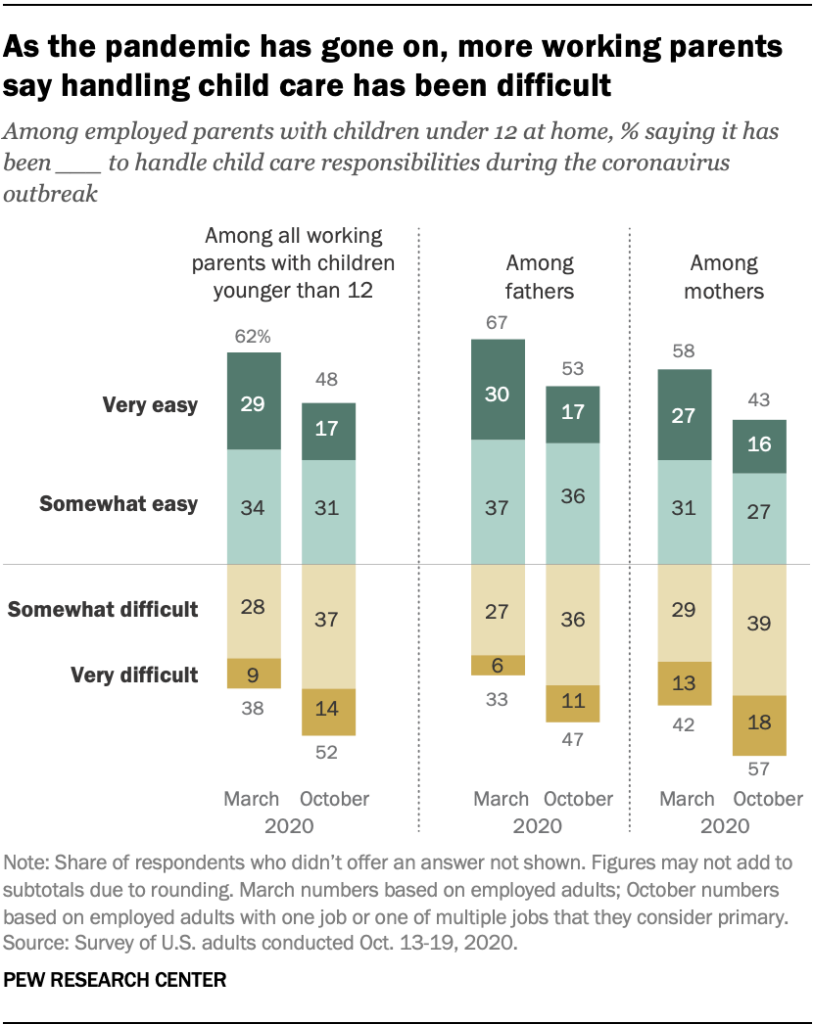

February 17, 2021
As schools continue to function under full or partial distance learning due to COVID-19, working parents with school-aged children face the daunting challenge of ensuring that their children are in a safe learning environment. This challenge is greater for low-income families and families who have inequitable access to education and health resources.
Less than half of low-income children have access to high-quality early childhood programs, largely because child care is primarily funded by parent fees. Supporting high-quality and accessible child care enables parents to work, attend school, and improve their outcomes while providing a safe environment for their children to learn. Moreover, investment in early child care and education programs has shown a myriad of benefits, such as providing more equitable long-term outcomes for children of marginalized backgrounds by providing the necessary support during a child’s critical development years.
Since most child care centers are supported by parent fees, many centers continue to struggle to meet both the rising demand in child care slots and the raising financial costs needed to safely operate. A survey from the National Association for the Education of Young Children (NAEYC) found that 30 percent of child care providers would not survive a short-term closure without public investment. During the spring of 2020, the coronavirus pandemic forced many child care providers to shut down, and large layoffs ensued. Now, the child care industry continues to suffer many financial challenges. New operating costs for centers are up to 60 percent higher than before the pandemic, as many providers must purchase personal protective equipment and even make physical infrastructure improvements to support new safety regulations. Further, facilities are faced with decreasing enrollment, on average, by 67 percent to maintain small groups and prevent the possibility of widespread infection.
Even before the pandemic, child care was extremely under-resourced and child care providers often operated under thin profit margins. Further, more than half of Americans already lived-in child care deserts, where demand for child care vastly exceeds the supply.
This interactive map provides detailed insight on child care impact and investigates correlations with racial and economic factors.
Public funding is limited for early child care and education. Most public funding stems from the Child Care and Development Block Grant (CCDBG) that works to fund child care for low-income families. In response to the pandemic, Congress passed the Consolidated Appropriations Act of 2021 to allocate $10 billion to the CCDBG, in addition to the $3.5 billion allocated through the CARES Act in March 2020. Despite these investments, the pandemic has highlighted the critical role child care plays in ensuring success in our economy. Working parents, recovering from economic hardship brought forth by the COVID-19 pandemic, require ample child care supply and capacity, as well as affordable, high-quality options as the economy reopens.
Throughout the pandemic there has been a growing share of working parents who struggle to handle child care responsibilities. Research finds that 52% of working parents with children younger than 12 report difficulty in handling childcare. Among working parents, child care responsibilities are more difficult for families with two working parents than compared with working parents who have a partner who is not employed. As low-income families are more likely to have two working parents, these families continue to face obstacles when searching for affordable, high-quality child care.
 Igielnik,R. (2021, January 26). A rising share of working parents in the U.S. say it’s difficult to handle child care during the pandemic. Pew Research Center. Retrieved from: https://www.pewresearch.org/fact-tank/2021/01/26/a-rising-share-of-working-parents-in-the-u-s-say-its-been-difficult-to-handle-child-care-during-the-pandemic/
Igielnik,R. (2021, January 26). A rising share of working parents in the U.S. say it’s difficult to handle child care during the pandemic. Pew Research Center. Retrieved from: https://www.pewresearch.org/fact-tank/2021/01/26/a-rising-share-of-working-parents-in-the-u-s-say-its-been-difficult-to-handle-child-care-during-the-pandemic/
The pandemic has had a severe impact on the early child care and education workforce, while also exacerbating continuous systemic inequities that exclude children from low-income families from access to high-quality child care and education. The dramatic shift to online learning has left many families, specifically low-income and families of color, struggling to balance non-remote work and their child’s virtual learning. As the pandemic continues and child care becomes increasingly relied upon for communities to return to typical environments, states should consider policy solutions that invest in dedicated child care stabilization while understanding child care closures will likely concentrate in low-income neighborhoods.
Focus on Supply Building | As the pandemic continues, the child care sector has faced a severe reduction in available slots. High-quality, licensed child care was already in short supply before the pandemic; therefore, stakeholders should aim to build or repair sustainable child care programs. To stabilize child care programs, stakeholders should consider creating grant programs for family child care providers’ COVID-19 related costs.
Target At-Risk Children | With low-income communities facing extreme difficulties in finding affordable, quality child care, stakeholders should consider establishing targeted supports to programs that work with high populations of children at the greatest risk of falling behind during virtual learning, such as children of color, children with special needs, and children of low-income families.
Support providers not currently in the subsidy system | With a low supply of quality caregivers despite the rising demand for high-quality child care, stakeholders should work to access CCDBG funds, state funds, private funds, and other resources to cover the costs necessary to provide support to programs and providers currently not within the CCDBG system.
Support essential workers | The federal government and states have drafted various definitions of essential workers, but often don’t include janitorial staff, grocery workers, and child care providers themselves. These occupations have proven to be essential to the economy, and therefore states should aim to provide subsidies for child care to all essential workers. States should ensure that essential workers are met with well-publicized and transparent information to ensure families with essential workers have the necessary resources to seek quality child care.
Expand eligibility | States should consider increasing eligibility levels to serve more families. States have traditionally limited access to subsidies over the years. The economic consequences caused by COVID-19 have left many families with limited resources but, families will require access to child care to return to work. Expanding eligibility levels will allow more families to receive care assistance that will support economic recovery.